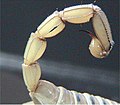Tail

The tail is the section at the rear end of certain kinds of animals' bodies; in general, the term refers to a distinct, flexible appendage to the torso. It is the part of the body that corresponds roughly to the sacrum and coccyx in mammals, reptiles, and birds. While tails are primarily a feature of vertebrates, some invertebrates including scorpions and springtails, as well as snails and slugs, have tail-like appendages that are sometimes referred to as tails. Tailed objects are sometimes referred to as "caudate" and the part of the body associated with or proximal to the tail are given the adjective "caudal".
Function
Animal tails are used in a variety of ways. They provide a source of
Tails are also used for social signaling. Some
Some species of
Most birds' tails end in long
The tails of grazing animals, such as horses, are used both to sweep away insects and positioned or moved in ways that indicate the animal's physical or emotional state.[16]
Human tails

In humans,
However, this is not a tail.[18] Infrequently, a child is born with a "soft tail", which contains no vertebrae, but onlyIn 2024 scientists claimed to have found a genetic mutation that contributed to the loss of the tail in the common ancestor of humans and other apes.[22][23]
Humans have a "tail bone" (the coccyx) attached to the pelvis; it comprises fused vertebrae, usually four, at the bottom of the vertebral column. It does not normally protrude externally - humans are an acaudal (or acaudate) species (i.e., tailless).
Gallery
-
Lion (Panthera leo)
-
Pig(Sus domestica)
-
Glyptodon (Glyptodon asper)
-
Longhorn cowfish (Lactoria cornuta)
-
Grévy's zebra (Equus grevyi)
-
American alligator (Alligator mississipiensis)
-
Hippopotamus (Hippopotamus amphibius)
See also
- Empennage, the tail of an aircraft
- Rump (animal)
References
- ISBN 978-0-521-24303-2.
- ISBN 978-0-674-04474-6.
- PMID 26479883.
- ISBN 978-1-59921-625-6.
- ISBN 978-0-435-58332-3.
- ISBN 978-0-8225-6765-3.
- ISBN 978-1-4684-1027-3.
- ISBN 978-0-87351-656-3.
- ISBN 978-1-118-05276-1.
- ISBN 978-0-7368-1318-1.
- ISBN 1-4160-6477-X.
- S2CID 40356618.
- ISBN 978-0-7566-6758-0.
- ISBN 978-0-7614-7145-5.
- ISBN 978-0-393-31167-9.
- ISBN 978-0-553-52368-3.
- ^ "Tail Bud". Merriam Webster. Retrieved 4 June 2020.
- ^ "Developmental Stages in Human Embryos: Stage 16". the Endowment for Human Development. Retrieved 4 June 2020.
What Kunitomo (1918) designated the "longest tail" at stage 16 is nothing of the kind but is merely the caudal end of the embryo, which will develop into the coccygeal region.
- ^ "Human tail–caudal appendage: tethered cord". Nature. February 1, 2008. Retrieved 2009-04-28.
- ^ "The 'human tail' causing tethered cervical cord". Nature. November 14, 2006. Retrieved 2009-04-28.
- PMID 22604513.
- ^ Weisberger, Mindy (March 23, 2024). "Why don't humans have tails? Scientists find answers in an unlikely place". CNN. Archived from the original on March 24, 2024. Retrieved March 24, 2024.
- PMID 38418734.
External links
 Media related to Tails at Wikimedia Commons
Media related to Tails at Wikimedia Commons








